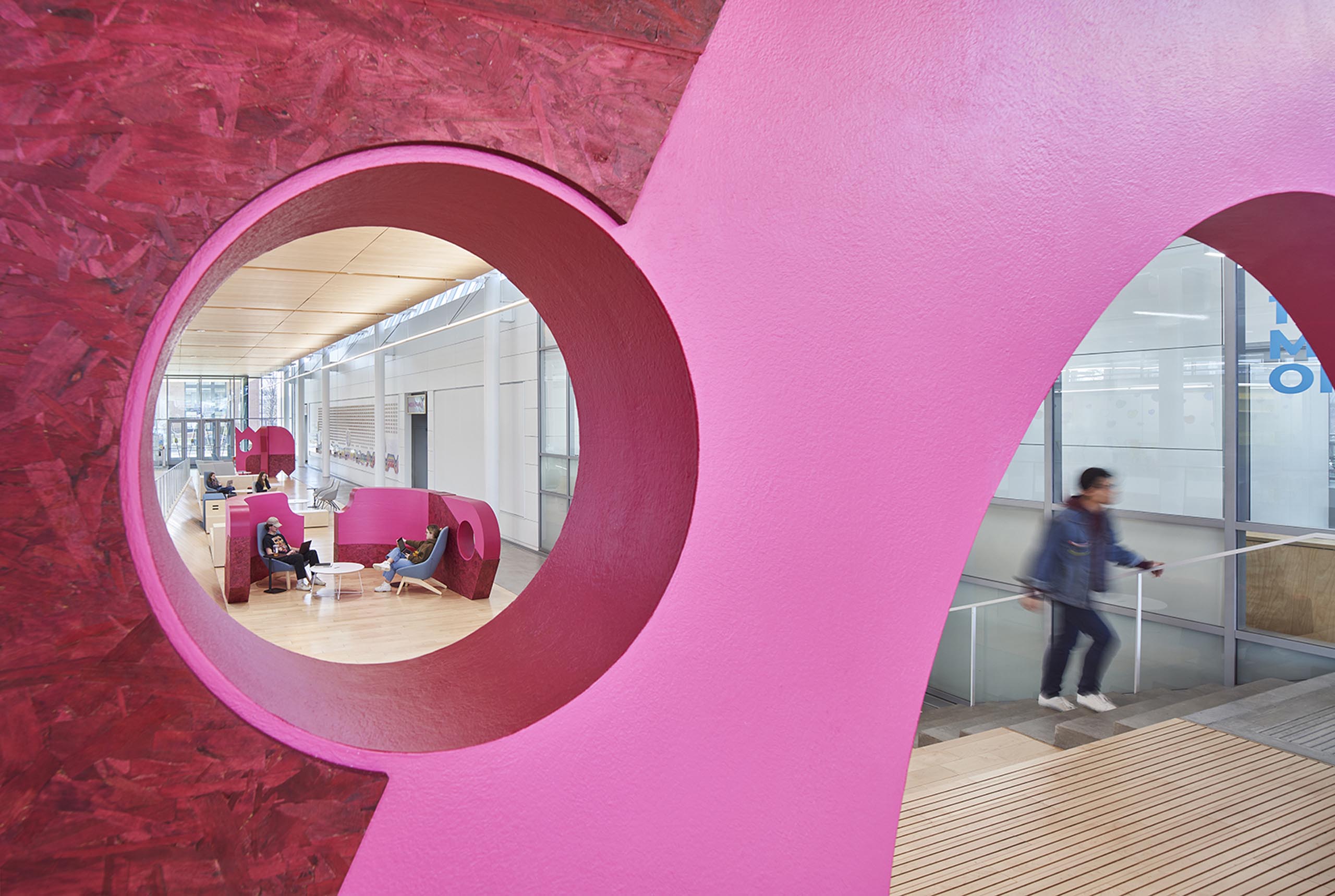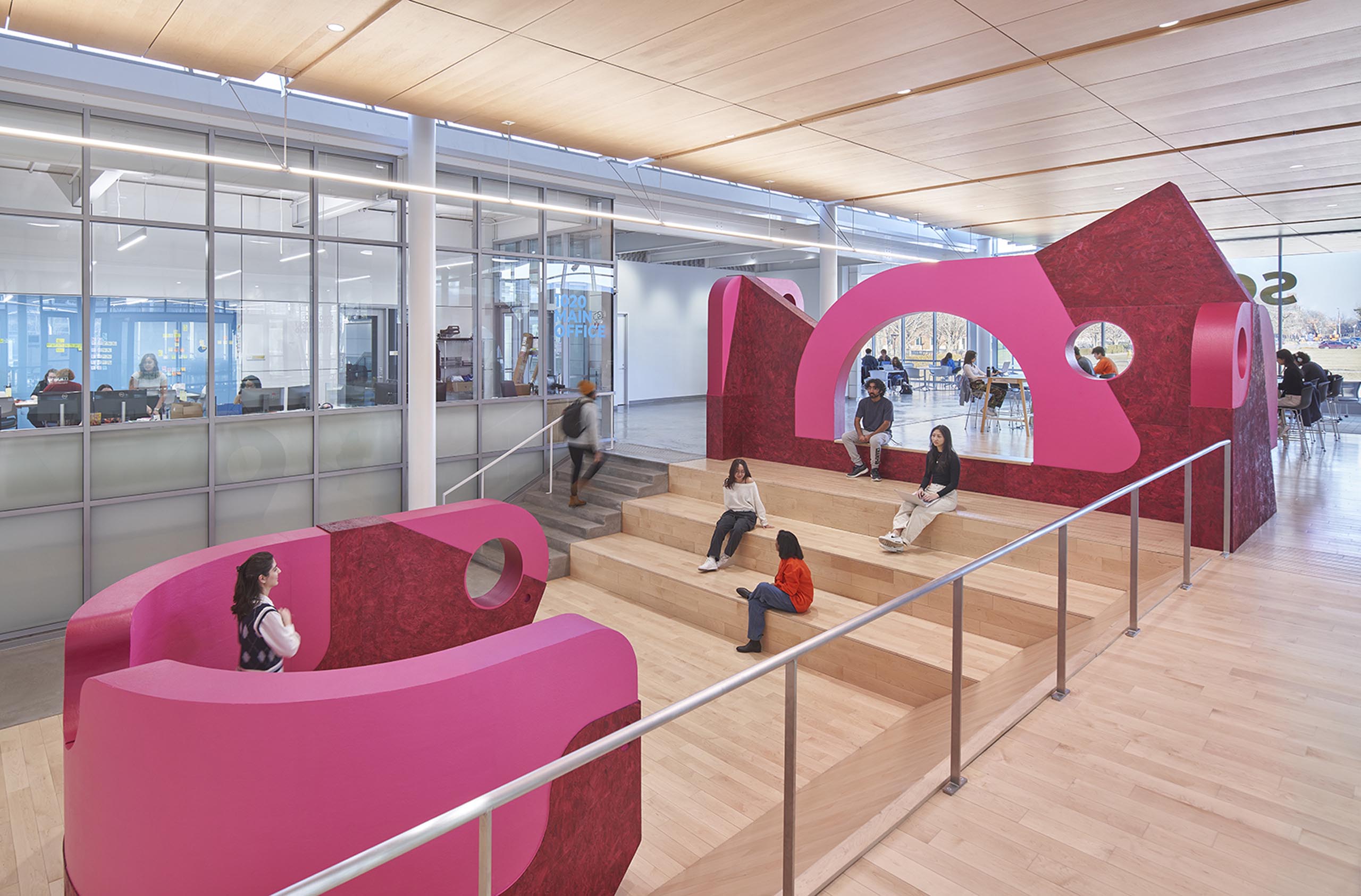Joseph Altshuler and Zack Morrison of Could Be Design: (Re)animated Arcade
One of six installations for the digital exhibition by winners of the 2023 League Prize.
This digital installation includes 3 short films by 3 different filmmakers that visually reinterpret Could Be Design’s 2023 installation, the Animate Arcade, located at the Siebel Center for Design at the University of Illinois at Urbana-Champaign.
Animate Arcade is a family of independent but related architectural “creatures” that populate the Siebel Center for Design’s public spaces with intimate pockets of personable programming. This series of installations activates the building’s interior by providing specific programmatic platforms and landmarks, including a welcome desk, a gateway arch, a mobile amphitheater backdrop for lectures/performances, and a mobile exhibition display kiosk that has wandered away from the pack.
The creatures of the Animate Arcade embody animated characteristics like personality, posture, facial expressions, charisma, and attitude that collectively initiate companionship with you, their human visitors, in order to prompt interactive encounters. Architectural zoomorphism (the phenomenon of spaces that resemble or behave like other animate creatures) encourages us, as humans, to read the world as composed almost entirely of lively beings with character which exist in relation to other beings at a range of scales and in various contexts. While de-centering a privileged human position is sometimes discomforting, this way of seeing the world provides an opportunity to redefine our own human personhood, and to acknowledge all that we have in common with other creaturely companions of the built environment.
Could Be Design asked the filmmakers to explore the animated qualities of the built installation that elicit discomfort and liveliness, in all of its many gradations. Taken together, the three films offer three different moods and modes of experiencing the Animate Arcade, including sensual interaction (Act 1), fashionable flamboyance (Act 2), and shape-shifting mystique (Act 3).
Act 1: Dance in the Animate Arcade
Directed by Lizi Breit
Sound by Sad Brad Smith
Produced by Could Be Design
“What are the rules of a built environment, and whose physical and emotional comfort do they protect? By running amok and asserting their physicality in the Animate Arcade, these massive, unbothered babies discover new and unorthodox ways of engaging with a world not designed for them, challenging the audience to notice their own feelings of discomfort that may arise while witnessing the dance.” —Lizi Breit
Act 2: Arcadias
Created by Nelly Agassi and Maya Raviv
Produced by Could Be Design
“Arcadias builds upon the filmmakers’ exploration of the concept of the “architectural woman,” using the forms originally created by Could Be Design as a foundational element. Within Arcadias, these forms undergo a transformation, embodying the presence of women who navigate a space where they are both the architecture and the inhabitants. This fusion of form and movement prompts contemplation on the dynamic interplay between architectural spaces and their users, as well as the profound relationship between humanity and architecture itself. Through its evocative choreography, Arcadias engages the collective imagination, inviting reflection on our connection to the constructed environment and the narratives shaped by human presence in contemporary spaces.” —Nelly Agassi and Maya Raviv
Act 3: Ambiguity Arcade
Directed by Myles Emmons
Produced by Could Be Design
“There is an inextricable discomfort or discontent that comes from the ambiguity of our existence. But don’t fret—it’s ok! Being uncomfortable is inherent and compatible with being. In fact, by accepting discomfort you are affirming your full humanity. This animation plays with the idea of fluid morphing between subject and object—never comfortable for too long with any one state of being. The unbounded nature of animation makes it an ideal vehicle to show the radical freedom humans have to define themselves and the world around them.” —Myles Emmons
Project credits
Design team Joseph Altshuler, Zack Morrison, Julia Sedlock, and Efrain Araujo
Fabrication Erica Gressman (Rainbolt Productions), and Andrés Lemus-Spont (Building Brown Workshop)
Installation assistants Shravan Arun and Amir Zarei
Photography Brian Griffin
Photography assistants Amir Zarei, Krishna Jayachandran Sailaja, Atousa Esmaeil, and Alejandro Toro-Acosta



